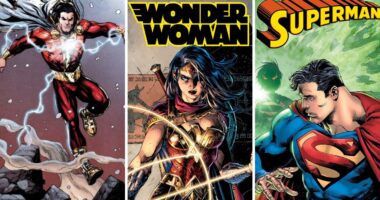Biography of George R. R. Martin | Books | Web Series: George Raymond Richard Martin was born on September 20, 1948. He is an American novelist, short story writer, television producer, and screenwriter. Martin is popular for his epic fantasy series A Song of Ice and Fire. They were adapted into the popular HBO series Game of Thrones and its prequel series House of the Dragon. In 2005, Lev Grossman of Time called him “the American Tolkien.” George R. R. Martin was included in the 2011 annual Time 100 list of most influential people in the world.
Early Life of George R. R. Martin
George Martin was born in Bayonne, New Jersey, the son of Raymond Collins Martin and Margaret Brady Martin. He has two younger sisters, Darleen and Janet. Martin’s childhood consisted predominantly of grade school and home. This limited world made him want to explore the world, and the only way to do that was through imagination. He had a habit of starting endless stories to never complete them.
He attended Mary Jane Donohoe School and later got admission to Marist High School. While there he became an avid comic reader, developing an interest in Marvel Comics. Later he credited Stan Lee as one of his greatest literary influences, even more than Shakespeare and Tolkien. In 1970 he earned a B.S. from Medill School, Northwestern University, in Journalism. He went on to complete his M.S. in Journalism in 1971 from Medill.

Career
George Martin began selling sci-fi short stories professionally in 1970 at the age of 21. Martin’s first sale was “The Hero”. His 1973 published “With Morning Comes Mistfall” was the first story to be nominated for the Nebula Awards and the Hugo Awards. The short stories he sold in his early 20s didn’t give him any profit to pay his bills. Martin’s chess skills allowed him to be hired as a tournament director for the Continental Chess Association. The tournaments only ran on Saturdays and Sundays, which gave him the money and also the time to write. By the time the chess craze was over he was already an established writer.
In the mid-1970s Martin met English professor George Guthridge at a sci-fi convention in Milwaukee. He helped Martin in finding a job at Clarke University. Martin was an English and journalism instructor at Clarke from 1976 to 1978. He became a Writer in Residence at the college from 1978 to 1979.
In late 1977 the death of a fellow author and friend Tom Reamy made him reevaluate his own life and he eventually decided to become a full-time writer. Although he often writes horror and fantasy, his earlier works are sci-fi loosely defined future history informally known as The Manrealm or The Thousand Worlds. in 2017 he recalled he started writing sci-fi horror hybrids during the late 1970s to contradict a statement from a critic claiming that horror and sci-fi were opposites and hence incompatible. He considered Sandkings and Nightflyers best of these.
George R. R. Martin – Themes and Inspirations
Jeff VanderMeer described George Martin’s writing as “complex storylines, fascinating characters, great dialogue, perfect pacing.” New York Times writer Dana Jennings described his work as “fantasy for grownups.” His first novel Dying of the Light set the tone for some of his potential work and it has a strong sense of melancholy. T.M. Wagner said, “Let it never be said Martin doesn’t share Shakespeare’s fondness for the senselessly tragic.” His characters are multifaceted with their intricate history, ambitions, and aspirations. There is always misfortune and death of major and minor characters which elevates the story’s depth.
He grounds his works on the foundation of historical fiction which he channels to evoke the significant political and social elements primarily during the European medieval era. Martin ensures through his works that magic is a part of his works which helps to move the story forward. It is not a generic dues ex machina. His ultimate aim is to explore the internal conflicts that describe the human condition, deriving inspiration from William Faulkner, he describes as the sole reason to read any piece of literature, regardless of genre.

Martin critiques the oversimplification of Tolkien’s themes and devices. Though he finds inspiration in Tolkien’s legacy, Martin aims to go beyond the “medieval philosophy”. Martin has been credited with the rise of a modern form of anti-Tolkien approach to fantasy writing known as grimdark fantasy. Canadian fantasy writer R. Scott Bakker says he wouldn’t have been able to publish his novels without George Martin’s success first.
In 2018 Martin shared his favorite books that changed his life – The Lord of the Rings, Gone with the Wind, Charlotte’s Web, The Great Gatsby, Lonesome Dove, Catch-22, and Great Expectations.
Personal Life
During the early 1970s, Martin was in a relationship with fellow sci-fi writer Lisa Tuttle and he co-wrote Windhaven with her. While attending an East Coast sci-fi convention he met Gale Burnick, and they got married in 1975. The marriage ended without issues in 1979 before they were supposed to move to Santa Fe. He settled there on his own until 1981 when his longtime partner Parris McBride moved in with him. In 2011, Martin and McBride got married. Both of them are supporters of the Wild Spirit Wolf Sanctuary present in New Mexico. In 2019, he opened Beastly Books, a bookstore after Beauty and the Beast. In response to questions regarding his religious views, he said he finds “religion and spirituality fascinating” and supposes himself as a “lapsed Catholic.”
He is a fan of the band Grateful Dead and says they might have influenced his work. Martin is also a fan of New York Giants, New York Jets, and the New York Mets.
Criticism
George Martin is opposed to fan fiction. He believes it is a bad exercise for the aspiring writer in terms of developing skills in character development and worldbuilding. Martin has received criticism from some of his readers for the gap between book releases in the A Song of Ice and Fire series. The criticism was especially about the six-year gap between A Feast for Crows and A Dance with Dragons. He reacted to this criticism by saying he was not willing to write only about the series and that writing other prose and editing has always been a part of his working process. Neil Gaiman has defended Martin and talked about fan criticism. He stated that writers have all the rights to focus on other projects and they are not machines.
Also Read: Pen Names of Some Famous Authors – How Many of Them You already Know About?



